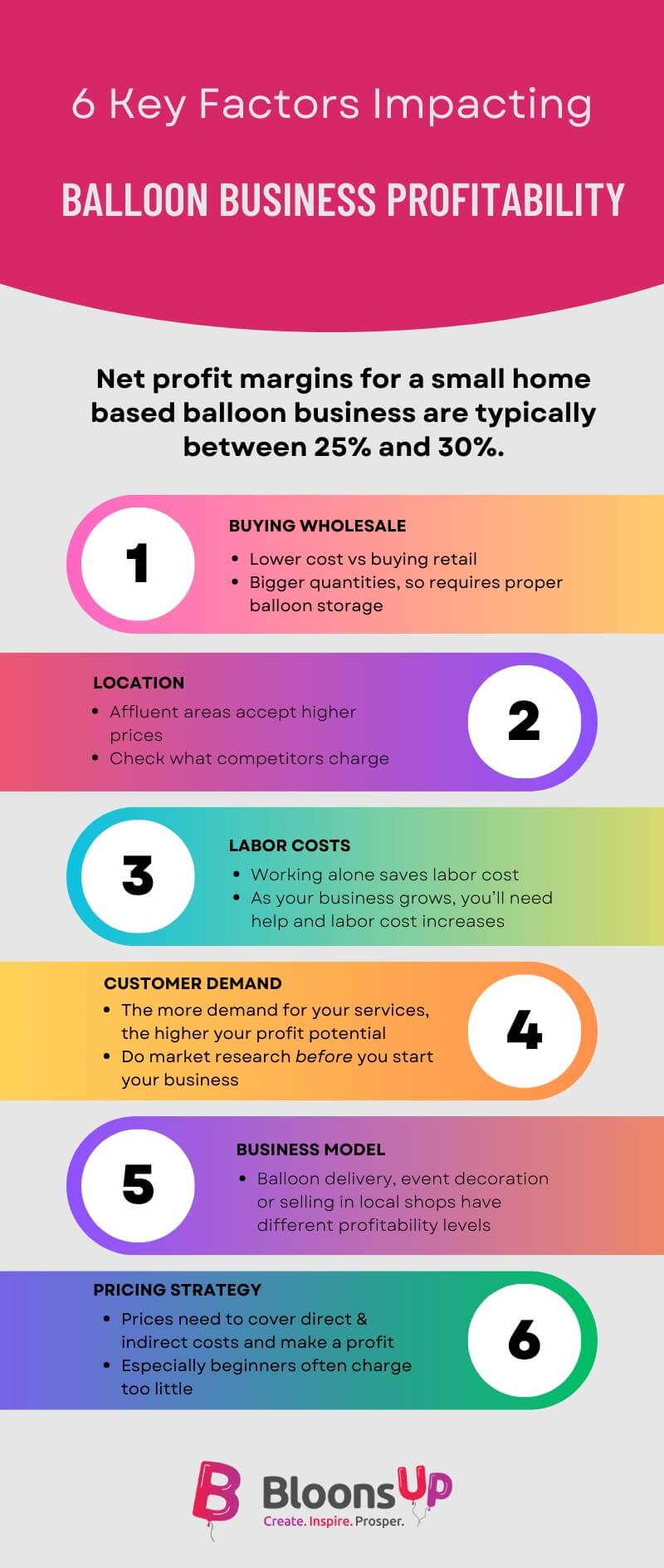Struggling to price arches & garlands? This NEW simple calculator does the math for you.
- Home
- Balloon Business Resources
- Balloon Business Profit Margins
Balloon Business Profit Margins: A Comprehensive Guide
As someone who loves working with balloons, perhaps you've been contemplating starting a balloon business from home.
Beyond the joy of bringing smiles to people's faces with your colorful balloon creations, you're probably wondering, "How profitable is a balloon business?"
Today, I'll provide you with a comprehensive guide on the profit margins of a balloon business, including all the factors that could influence it.
If you make a purchase through a link on my site, I may receive a small commission at no extra cost to you. I only recommend products that I believe to have good value (affiliate disclosure).
Understanding Balloon Business Profit Margins
What do we mean when we talk about profit margin? There are two different types of profit margin: gross profit margin and net profit margin. Both are ways how businesses measure their profitability, but they consider different sets of costs.
Gross profit margin is what you get when you subtract the cost of making a product from the selling price. It only considers the "direct" costs, like materials and labor that go into creating the product.
For example, if it costs you $5 to make a balloon centerpiece and you sell it for $10, your gross profit margin is $5 or 50%.
Net profit margin, on the other hand, takes into account all the costs involved in running a business – not just the direct costs of producing a product.
So, this includes indirect costs, like rent, utilities, salaries of employees who do not directly participate in producing the product, marketing expenses, and taxes.
For example, if you sold the balloon bouquet for $10, and it cost $5 to make it, but you also spent another $3 on rent, employee salaries, utilities and advertising etc., this leaves you with $2. So your net profit margin will be $2 or 20%.

Basically, gross profit margin is like how much you initially earn from selling a product, while net profit margin is what you get to keep after you have paid for everything that supports your business.
For our purpose, net profit margin is the more important value, as it's the most accurate measure of the financial health of your business.
In the case of a balloon business, profit margins typically vary based on factors such as business size, types of service, geographical location, and overhead costs.
For small, home-based balloon businesses, the net profit margin usually sits between 25% to 30%. This implies that if your daily sales were $100, your net profit would be around $25 to $30.
According to the pros who've been in the industry for a long time, like for example Sue Bowler from The Very Best Balloon Blog and Mark Drury from Qualatex, the absolute minimum net profit margin should be 15% to 20%.
The higher, the better of course. One thing to know is that the profit margin doesn't have to be the same for each job. So you may well have orders where your margins reach up to 35% to 40%.
Typical Factors Impacting Balloon Business Profitability
Several factors can impact the profitability of your balloon business. Understanding them is crucial for accurately projecting your potential income.
1. Buying Wholesale
Buying materials and tools from wholesalers rather than retail shops will lower your expenses and increase profitability. Wholesalers often require that you buy larger quantities, so you need to make sure that you store your balloons properly.
2. Location
The area you are serving impacts your pricing structure. In affluent areas you can often charge higher prices for the same product.
3. Labor Costs
If you're running the business alone from home, you can save on labor costs. If and when your business grows (which is a good thing!), you'll need to hire additional hands.
While this may mean that your profit margin goes down, your overall income may still increase because you can do more and bigger jobs.
4. Customer Demand
As with any business, the more demand for your products or services, the more profitable your business will be. That's why it's so important to do thorough market research before you start your balloon business. I teach how to do this in lesson two of my balloon business course.
5. Business Model
Depending on what type of jobs you'll focus on, your profit margin will vary. Balloon delivery, decorations for events, or selling in local shops all have different profitability levels.
6. Pricing Strategy
Knowing how to price your balloon designs correctly is one of the most important factors for your profitability. Many balloon decorators, especially when starting out, don't charge enough for their work.
The price you set for your balloon arrangements must cover your costs (material, labor, overhead) and generate a healthy profit.
Pros and Cons of Starting a Balloon Business
Let's finish our deep dive into balloon business profit margins by looking at the pros and cons of starting a balloon business.
Pros of Starting a Balloon Business
High Profit Margins
According to a 2023 study by New York University, the average net profit margin in the U.S. across different industries sits between 8% and 9%
So if your balloon business can even achieve 15% to 20%, you're way above average.
Home-Based Operations
You can start your balloon business from home, reducing overhead costs.
Low Investment Initially
You can start small, by purchasing the absolute minimum equipment and materials needed. More expensive items like electrical balloon inflators can also often be found second hand, for example on eBay or in balloon decorating Facebook Groups.
Flexibility
The balloon business enables you to work on your terms, perfect for stay-at-home moms or dads.
Cons of Starting a Balloon Business
Irregular Working Hours
Events often take place during weekends, evenings, and holidays, which can be challenging for your family life.
Handling of Helium
If you're dealing with helium-filled balloons, you need to know how to handle helium tanks safely.
Space Requirements
You need a suitable area for storing materials and tools and for assembling parts or all of your designs at home.
Transport Vehicle
You need a large enough car for transporting the balloons, bases, frames etc. to the venue.
Conclusion: Is a Balloon Business Profitable and is it Right for You?
We've established that a balloon business can generate a decent profit, as long as you use the right pricing strategy and are aware of the factors that influence its profitability.
However, profit shouldn't be the only reason for becoming a professional balloon decorator.
Other questions to ask yourself before making a decision:
- Do you enjoy working with balloons enough to make it your main or part-time job?
- Are you and your family okay with you having to work evenings, weekends and holidays?
- Do you see enough demand for balloon decorations in your area, or is there already strong competition?
- Are you willing to deal with customers, even if they have unreasonable expectations?
Think these things through.
Want more guidance on whether a balloon business is right for you, and how to start one with confidence? Consider signing up to my eCourse "How to Start Your Own Balloon Decorating Business - 7 Easy Lessons to Success."
Video Tutorial: 7 Free or Low Cost Ways to Market Your Business
Video Tutorial: How to Price Your Balloon Decor
How to Choose a Catchy Name for Your Balloon Business





![Balloon Drop at a Party [Image Source: Eventbrite.com]](/image-thumbnails/how-can-i-make-a-balloon-drop-for-a-wedding-and-is-there-a-way-of-releasing-them-21850402.jpg/default.webp)
![Balloon Heart Frame [Image source: Aliexpress.com]](/image-thumbnails/where-can-i-buy-balloon-heart-frames-21973261.jpg/default.webp)
Have your say about what you just read!
Leave me a comment in the box below. Don't see the comments box? Log into your Facebook account, give Facebook consent, then return to this page and refresh it.